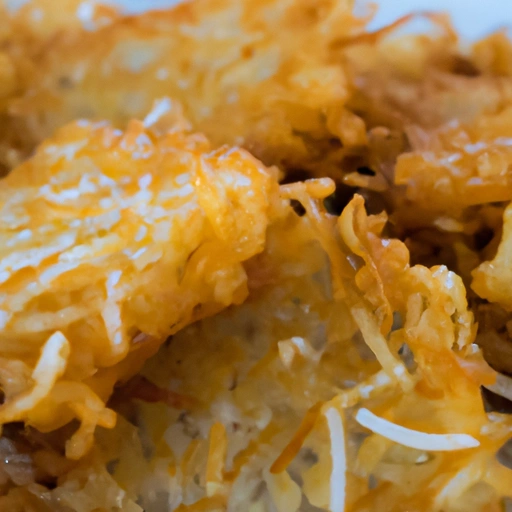Hash Brown
Description

Hash browns are a staple breakfast item traditionally made from shredded or diced potatoes that are pan-fried until crisp and golden brown. They are a beloved dish in both American and European cuisines and are enjoyed for their crunchy texture and savory flavor. The versatility of hash browns makes them an excellent base for a variety of toppings and mix-ins.
Common uses
Hash browns are commonly served as a breakfast or brunch side dish, often accompanying eggs, bacon, and toast. They are also popular as a standalone meal or as part of a larger breakfast platter. In some regions, hash browns are used as a filling for breakfast burritos and sandwiches, adding texture and flavor to these savory creations.
Nutritional value
Calories
A typical serving of hash browns (about 3.5 oz or 100 grams) contains approximately 150-200 calories, depending on the cooking method and added ingredients.
Protein
Hash browns generally contain about 2-3 grams of protein per serving, as potatoes are not a high-protein food.
Fat
The fat content in hash browns can vary widely from 9 grams to 15 grams per serving, largely due to the amount and type of oil used in cooking.
Carbohydrates
Potatoes are a carbohydrate-rich food, and a serving of hash browns typically contains around 15-20 grams of carbohydrates.
Vitamins
Potatoes, the primary ingredient in hash browns, provide a source of vitamin C and B vitamins, although the content may be reduced through the cooking process.
Minerals
Hash browns contain essential minerals such as potassium and magnesium, which are naturally found in potatoes.
Health benefits
Hash browns can be part of a balanced diet, providing energy from carbohydrates and nutrients from potatoes. When cooked with minimal oil, they can be a lower-fat option for those looking to maintain a healthy eating regimen.
Potential risks
Overconsumption of hash browns can lead to an excessive intake of calories and fat, particularly if they are fried in large amounts of oil or butter. Additionally, toppings and condiments often add extra calories and sodium.
Common recipes
Hash browns are a key ingredient in breakfast casseroles, omelets, and can be served as a base for a hearty meal topped with fried eggs, bacon, or cheese.
Cooking methods
The most common cooking methods for hash browns include pan-frying, baking, and even air-frying for a lighter version. They can be prepared from fresh or frozen shredded potatoes.
Pairing with other ingredients
Hash browns pair well with savory toppings such as sour cream, chives, melted cheese, sautéed onions, and green peppers. They also complement a variety of sauces, including ketchup, hot sauce, and gravy.
Summary
Hash browns are a versatile and popular food ingredient that can be enjoyed in a myriad of ways. Whether you're creating a simple breakfast dish or an elaborate brunch spread, hash browns offer a delightful texture and flavor that enhances any meal. They can be healthful when cooked in moderation and served with nutrient-dense toppings, making them a worthwhile addition to your culinary repertoire.